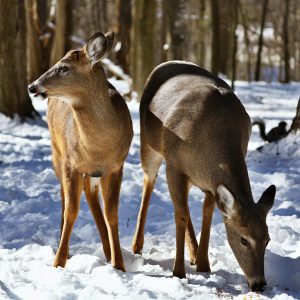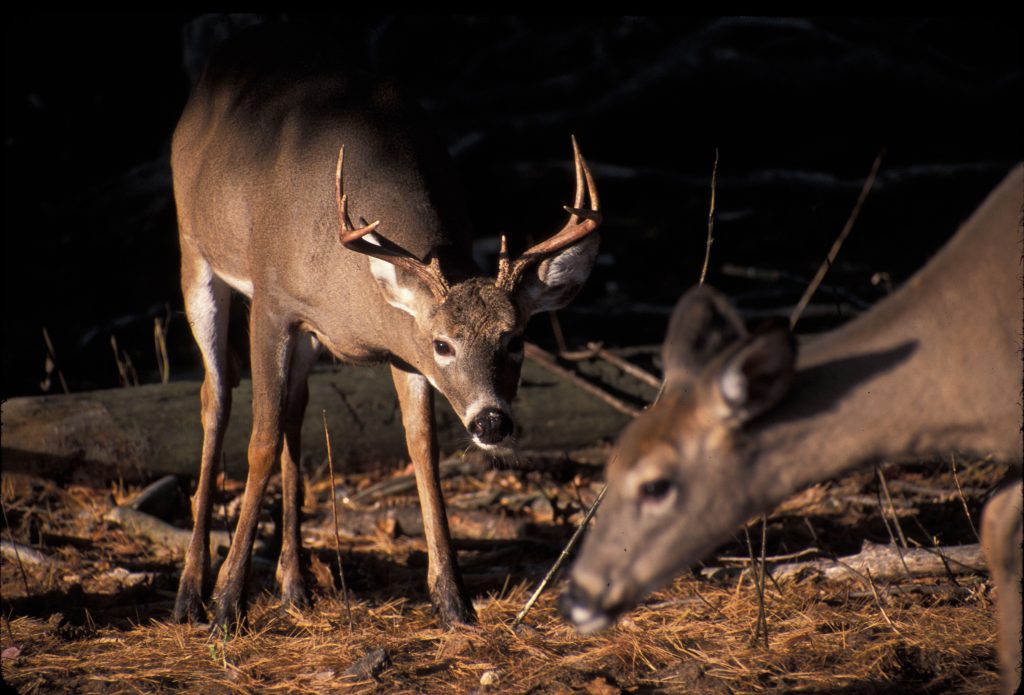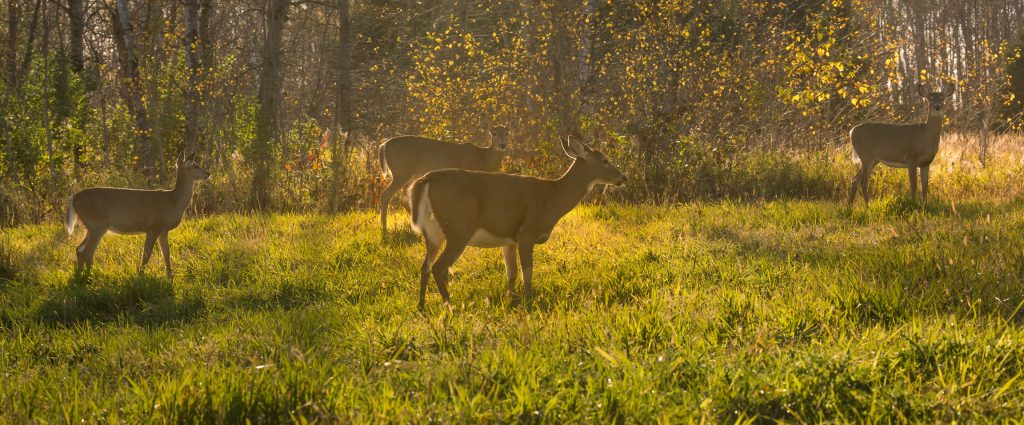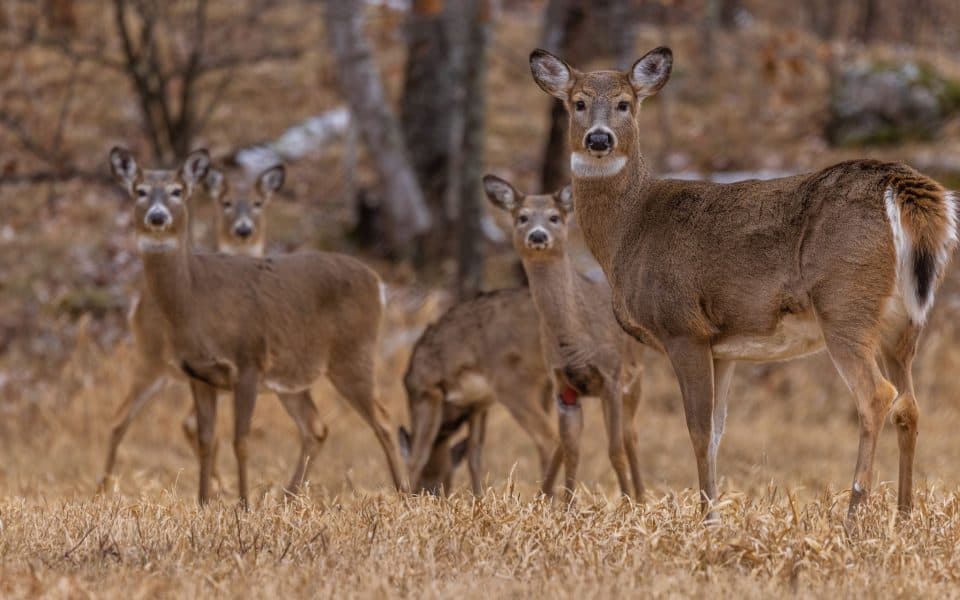The sound of approaching footsteps in dry leaves quickened my pulse and seemed to steal valuable oxygen from my breath. No question, it was a deer, but was it a buck or a doe? Sound materialized into movement, patches of brown and white filtering through the firs. My bow hand clenched and I re-checked the release clip on my string loop. Just a few more steps and … a doe. Seeing her antlerless head, I instantly switched into a more relaxed state. She was not my target today.
It’s funny how that works. Had I been after a doe, or any deer, I would have been just as excited as if the king of the forest stepped out, adrenaline pumping and short of breath. My objective on this day was a buck, but after the doe moved out of sight it got me to thinking about why I had passed her up. There were many factors involved in that decision and under slightly different circumstances, things could have unfolded quite differently. There are numerous reasons when and where it might be appropriate to shoot a doe. Let’s take a look at the what, when, where, how and why of harvesting does, in no particular order and with considerable overlap because they’re all inter-related.
What Does To Harvest?

Tes Jolly
Let’s start with what we’re targeting, and the simple answer is “does” – female deer. It seems straightforward, but even that is an important distinction because most state regulations only distinguish between “antlered” and “antlerless deer.” The latter would also include buck fawns or “button bucks,” which is probably not something you want included in your doe harvest unless your ground is grossly overpopulated. Mistakes happen and in most cases, it’s no big deal. Still, it doesn’t hurt to be careful.
If you’re limiting your antlerless harvest to just does, the next question is which ones? Here, as in other cases, it depends. The short and somewhat tongue-in-cheek answer is usually the one that offers the best shot. If you have multiple options, it depends to some extent on your specific objectives.
Let’s take a moment to look at population dynamics as they relate to this and several of the other questions. First, there’s basic population growth. Removing a buck means one less deer this winter, and next fall. Removing a doe means one less deer this winter but could mean, one, two, or three fewer next fall. Part of this depends on when – which we’ll get to in a bit.
Age also factors in. In general, a “doe fawn” will not breed, or give birth as a yearling; however, there are exceptions. Therefore, a doe fawn is minus just one, and some of the tenderest venison you’ll ever eat. A yearling doe probably will breed and is more likely to give birth to a singlet the following year, though twins are not uncommon. So let’s call that a minus 2.5 – she and her offspring won’t be around next fall. On average, an adult doe should have two fawns, so removing her is a minus three. Even that doesn’t sound like much, but extrapolate it over a few generations and it can make a big difference.
That’s a fairly basic explanation but it’s not quite that simple in reality. Just because a doe bears two fawns doesn’t mean they’ll make it through their first year, or even the first few months. Fawn mortality rates can vary highly from year to year depending on climate, moisture and food availability, and from place to place depending on predation rates and other variables. (As a side note, this also contributes to the myth of the old, dry doe). However, older, more experienced does tend to make better mothers and their offspring have better survival rates.
They’re also the nucleus of family groups. While yearling bucks tend to disperse more widely, yearling does usually stick close to their natal range, when they’re old enough to disperse. Though it’s a rather simplistic and general explanation, biologists refer to this as the “rose petal effect.” One doe bears two fawns. They leave their natal home range and establish a new one nearby, adjacent to, and possibly even overlapping their mother’s. If you were to plot the home ranges of successive generations, the chart might look something like a rose, each new home range being a petal.
It would be a bit more chaotic if you took out the nucleus. Prime habitat won’t go unoccupied, but it might take the new occupant several seasons to learn the best food sources, and the best places to avoid predators and hunters, which could lead to lower fawn survival rates. If the population is too high, remove what you can. If it’s close to objective levelsm, but you need to take out a few “mouths” to keep it that way, try to target younger does. It depends on your objectives, which brings us to “why.”
Why Harvest Does?

jitkagold
There are many motivations for harvesting or killing does. It’s a subtle distinction but worth noting because it sometimes depends on motivation. If your primary motivation is management and meeting population objectives, “harvest” seems a more appropriate term. If your goal is success and fresh venison, your goal is to kill a deer.
Does represent the reproductive potential of the population, so the quickest and most efficient way to manage a herd is by targeting them. In simple terms, if the population is too high, harvest more does. If it’s stable, you still need to take a few to keep it that way. If it’s low, let it grow by passing up a doe.
How Many Does to Harvest?
Somewhat related to which does to shoot is how many. The answer depends on specific objectives and the current herd status in relation to those objectives. Under most conditions, you can always remove a few without doing too much harm. Even if you over-harvest, white-tailed deer are prolific producers and the herd should recover in a year or two. If your population is robust, you probably can’t harvest enough, and there’s a fair amount of research demonstrating this. As you shoot more, encounters go down, and it’s not just because there are fewer deer. Those that remain simply move less during daylight and more in thick cover.
Before you decide “where to go,” you need to know “where you are.” If you’re not proficient at this it could be worth the investment of hiring a consulting biologist, or get help from your state wildlife agency if they provide it. They can usually tell you whether your deer herd is in balance with available food and habitat. They may even be able to prescribe how many deer should be removed.
When To Harvest Does?
Let’s move onto “when” you should harvest does, beginning with the basics. Fall is the traditional harvest season because it is a time of plenty, preceding a period of scarcity. Plant and animal growth slows or ceases and animals are fattening up for winter. Some will make it through and others won’t. The fewer mouths to feed, the more food to go around, so the best time to remove does is in the fall. Culling to reduce crop depredation may be one exception, but its more agriculture than wildlife management.

Bob Humphrey
If the population is too high, take a doe any time you can. If it’s stable, you might be a little more selective. There’s no wrong answer, but my bias tends toward early removal, based on the cost / benefit ratio of herd energy. Deer need energy to survive, but must expend energy to feed. If the ratio is favorable, the individual remains alive. They get it from food, often food you provide in the way of food plots and mast orchards. In essence, you’re investing energy in the population in hopes of realizing some benefit. Remove one doe early in the season and you take out what you, and she put in.
They also need and expend energy to reproduce. A buck may expend considerable energy pursuing, wooing and eventually breeding a doe. If you remove a doe after the rut and all that energy expended by the buck was for naught. Not only are you removing a doe and her growing offspring, you’re also taking out the investment that buck made before it had time to accrue interest – the penalty for late withdrawal.
There is also a behavioral advantage to early doe removal. Fewer does means more competition. That, in turn can lead to a more compact, more intense rut. Depending on population dynamics, it could also reduce the proportion of yearling bucks involved in breeding.
While it won’t make much difference from a management standpoint, the time of day you harvest does could influence your hunting. Intuitively, you would expect the best time would be twilight, when deer are most active. That’s not necessarily the case, unless removing does is your sole or primary objective. Twilight will be the most effective time, but you’ll also be educating other deer and possibly reducing your chances of later harvesting a buck.
This isn’t just my opinion. I’ve been on a lot of guided hunts or the guest on someone else’s ground and in almost every instance they asked, and in some cases told me not to shoot a doe early in the morning or late in the afternoon. A far better tactic for afternoon hunts is to take a doe early, leaving enough time for things to settle down before dark. In the morning, wait until the action dies down and if a late doe wanders by have at it. Of course, the exception to this is during the rut, when any doe represents live bait.
Where To Harvest Does?

Linda Arndt
This one is similar to several of our other questions, and largely also includes “how” and “when.” If your goal is population reduction, remove does where and when you can. However, even in high populations, and especially in lower ones, you might consider a more cautious approach.
Those food plots you built weren’t just to provide energy to the growing herd. They’re also to attract deer so you can extract some of that energy for yourself. Start knocking down does in your cool season hunting plots and the other deer will wise up quickly and will spend more time elsewhere. However, you built those plots to kill both bucks and does, right? Fair enough.

Bob Humphrey
Let’s jump back to “when” for a moment and remember to avoid peak movement periods. If you really want to shoot a doe in the morning, or at least have that as a serious option, move back away from the plot and into the woods where you’ll cause less disturbance. Much the same logic applies to concentrated natural food sources and travel corridors. It really comes down to common sense. If you’re targeting bucks, but want or need to remove a few does, don’t burn out your hotspots. If your goal is any deer, play the best hand you have.
The Best Way to Harvest Does
Now we get to the fun part. Use your weapon of choice, but keep in mind the importance of minimizing disturbance. If your harvest objectives are modest, archery might be a better option for culling. If you need to remove a lot of animals, the most effective means will usually be firearms.
Does sometimes get a bad rep as being easy pickings and targets of opportunity, but as experienced hunters know, there’s no warier whitetail in the woods than an old long-nosed matriarch. She’s learned how to survive and avoid danger, and all that snorting and foot stomping is only teaching other deer to avoid your stand. That alone might be sufficient cause to take her out for dinner. Then again, she’s doing a good job of securing the herd’s future. In the end, it’s your decision when, where, how and why to shoot a doe.
Join our weekly newsletter or subscribe to GameKeepers Magazine.
Your source for information, equipment, know-how, deals and discounts to help you get the most from every hard-earned moment in the field.









